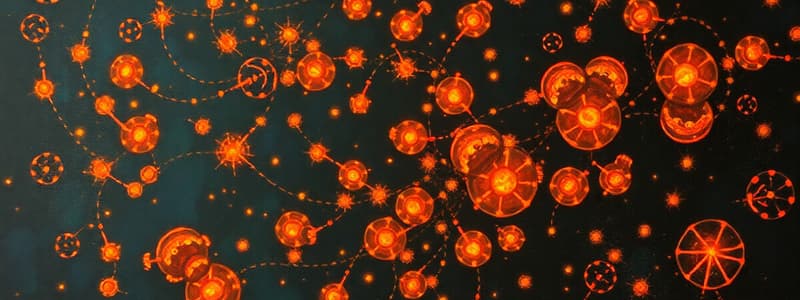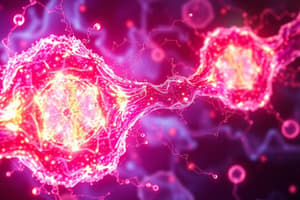Podcast
Questions and Answers
What is a key characteristic of mutated Ras protein?
What is a key characteristic of mutated Ras protein?
- It is constitutively active due to slow hydrolysis of GTP (correct)
- It prevents membrane association of RAS
- It hydrolyzes bound GTP very quickly
- It binds GTP more effectively than normal Ras
Which approach is suggested as the most favorable current method for targeting RAS?
Which approach is suggested as the most favorable current method for targeting RAS?
- Searching for synthetic lethal interactors
- Blocking RAS membrane association
- Direct inhibitors of RAS
- Targeting RAS downstream effector signaling (correct)
What recent development has sparked hope for RAS-targeting therapies?
What recent development has sparked hope for RAS-targeting therapies?
- Breakthroughs in RAS structural biology
- Renewed interest in developing RAS-inhibitory molecules (correct)
- Ability to enhance GTP binding in RAS
- Identification of effective pharmacological inhibitors
Which of the following is NOT mentioned as a potential approach to target RAS?
Which of the following is NOT mentioned as a potential approach to target RAS?
What is a widely held perception regarding RAS proteins?
What is a widely held perception regarding RAS proteins?
What type of mutations are classified as oncogenes?
What type of mutations are classified as oncogenes?
What is the role of the SH2 domain?
What is the role of the SH2 domain?
Which of the following pathways does Ras primarily activate?
Which of the following pathways does Ras primarily activate?
Approximately what percentage of human cancers contain mutant versions of RAS genes?
Approximately what percentage of human cancers contain mutant versions of RAS genes?
How does Ras mediate signaling for most receptor tyrosine kinases (RTKs)?
How does Ras mediate signaling for most receptor tyrosine kinases (RTKs)?
What does Raf do in the MAP kinase signaling cascade?
What does Raf do in the MAP kinase signaling cascade?
Which of these statements best describes the overall signal transduction system mediated by Ras?
Which of these statements best describes the overall signal transduction system mediated by Ras?
What is one of the main roles of Ras proteins in the cell?
What is one of the main roles of Ras proteins in the cell?
What is the first step in the MAP kinase signaling cascade initiated by Ras?
What is the first step in the MAP kinase signaling cascade initiated by Ras?
Which of the following proteins does MAP kinase (Erk) phosphorylate?
Which of the following proteins does MAP kinase (Erk) phosphorylate?
What type of cells were used in the experiments to analyze the effects of oncogenic DNA?
What type of cells were used in the experiments to analyze the effects of oncogenic DNA?
What was the outcome of introducing fragmented DNA from cancer cells into 3T3 mouse fibroblasts?
What was the outcome of introducing fragmented DNA from cancer cells into 3T3 mouse fibroblasts?
What characteristic of 3T3 cells made them suitable for studying the effects of oncogenic DNA?
What characteristic of 3T3 cells made them suitable for studying the effects of oncogenic DNA?
What was the primary goal of introducing cancer cell DNA into the 3T3 fibroblasts?
What was the primary goal of introducing cancer cell DNA into the 3T3 fibroblasts?
What was concluded about the colonies that formed as a result of the experiments?
What was concluded about the colonies that formed as a result of the experiments?
What is the primary function of KRAS in cancer?
What is the primary function of KRAS in cancer?
What is AMG 510 primarily classified as?
What is AMG 510 primarily classified as?
What effect did AMG 510 have in preclinical analyses?
What effect did AMG 510 have in preclinical analyses?
What significant effect did AMG 510 have on the tumor microenvironment?
What significant effect did AMG 510 have on the tumor microenvironment?
What type of tumors did cured mice reject in the studies?
What type of tumors did cured mice reject in the studies?
What was the significance of the FDA approval for adagrasib?
What was the significance of the FDA approval for adagrasib?
How do scaffolding proteins influence signaling pathways?
How do scaffolding proteins influence signaling pathways?
Which of the following is NOT a characteristic of some scaffolding proteins?
Which of the following is NOT a characteristic of some scaffolding proteins?
What is a key function of Rho family GTPases?
What is a key function of Rho family GTPases?
What inhibits Rho family GTPases from interacting with its GEF at the plasma membrane?
What inhibits Rho family GTPases from interacting with its GEF at the plasma membrane?
Which of the following pathways do GPCRs and RTKs predominantly activate?
Which of the following pathways do GPCRs and RTKs predominantly activate?
What role does the SRC homology domain play in signaling?
What role does the SRC homology domain play in signaling?
Which mutation type is primarily associated with oncogenes?
Which mutation type is primarily associated with oncogenes?
What is the primary function of SRC in cellular processes?
What is the primary function of SRC in cellular processes?
What do the SH2 and SH3 domains of SRC primarily facilitate?
What do the SH2 and SH3 domains of SRC primarily facilitate?
What is the result of a gain-of-function mutation in a proto-oncogene?
What is the result of a gain-of-function mutation in a proto-oncogene?
What is the relationship between c-src and v-src?
What is the relationship between c-src and v-src?
How does phosphorylation at Tyr527 affect c-Src's activity?
How does phosphorylation at Tyr527 affect c-Src's activity?
What type of virus was pivotal in the discovery of oncogenes?
What type of virus was pivotal in the discovery of oncogenes?
What was discovered about the DNA incorporated by retroviruses like RSV?
What was discovered about the DNA incorporated by retroviruses like RSV?
What kind of kinases are SRC and c-Src classified as?
What kind of kinases are SRC and c-Src classified as?
What is the designation given to the mutated version of a proto-oncogene?
What is the designation given to the mutated version of a proto-oncogene?
What role did Peyton Rous play in the study of oncogenes?
What role did Peyton Rous play in the study of oncogenes?
Flashcards
Oncogenic DNA
Oncogenic DNA
DNA fragments from cancer cells that cause uncontrolled cell growth.
3T3 cells
3T3 cells
Mouse fibroblast cells commonly used in experiments because they proliferate indefinitely in culture.
DNA fragment
DNA fragment
A portion of a DNA molecule isolated in experiments to insert into mouse cells.
Clone origin
Clone origin
Signup and view all the flashcards
Proto-oncogene
Proto-oncogene
Signup and view all the flashcards
Non-receptor tyrosine kinase
Non-receptor tyrosine kinase
Signup and view all the flashcards
RTK
RTK
Signup and view all the flashcards
SRC
SRC
Signup and view all the flashcards
SH2 and SH3 domains
SH2 and SH3 domains
Signup and view all the flashcards
Oncogene
Oncogene
Signup and view all the flashcards
Gain-of-function mutation
Gain-of-function mutation
Signup and view all the flashcards
Rous Sarcoma Virus (RSV)
Rous Sarcoma Virus (RSV)
Signup and view all the flashcards
v-src
v-src
Signup and view all the flashcards
c-src
c-src
Signup and view all the flashcards
Oncoprotein
Oncoprotein
Signup and view all the flashcards
Constitutively Active Ras
Constitutively Active Ras
Signup and view all the flashcards
RAS-Map Pathway
RAS-Map Pathway
Signup and view all the flashcards
Drugging the Undruggable RAS
Drugging the Undruggable RAS
Signup and view all the flashcards
Targeting RAS Downstream Signaling
Targeting RAS Downstream Signaling
Signup and view all the flashcards
Trans-autophosphorylation
Trans-autophosphorylation
Signup and view all the flashcards
SH2 domain
SH2 domain
Signup and view all the flashcards
MAP kinase pathway
MAP kinase pathway
Signup and view all the flashcards
Enzyme-Coupled Receptor
Enzyme-Coupled Receptor
Signup and view all the flashcards
Receptor Tyrosine Kinase (RTK)
Receptor Tyrosine Kinase (RTK)
Signup and view all the flashcards
KRAS(G12C)
KRAS(G12C)
Signup and view all the flashcards
AMG 510
AMG 510
Signup and view all the flashcards
Covalent Inhibitor
Covalent Inhibitor
Signup and view all the flashcards
Anti-tumor Immunity
Anti-tumor Immunity
Signup and view all the flashcards
Immune-Checkpoint Inhibitors
Immune-Checkpoint Inhibitors
Signup and view all the flashcards
Adaptive Immunity
Adaptive Immunity
Signup and view all the flashcards
Accelerated Approval
Accelerated Approval
Signup and view all the flashcards
Study Notes
Cell Signaling and Signal Transduction
- Cell signaling is a communication process between cells
- Signaling molecules are synthesized and released, travel to the target cell, bind to a receptor, resulting in a conformational change in the receptor
- The receptor initiates intracellular pathways resulting in changes in cellular function, metabolism, gene expression, shape, and movement
- Signal transduction pathways involve phosphorylation and dephosphorylation events, which cause changes in protein activity, often enabling or inhibiting ligand binding
- GTP-binding proteins act as molecular switches, activating or inactivating target proteins
- Enzyme-coupled receptors are transmembrane proteins with an intrinsic kinase activity or an associated kinase; they are activated by ligand binding, and initiate intracellular signaling cascades
- RTKs (Receptor Tyrosine Kinases) are the most common enzyme-coupled receptors, and are important in many cellular processes
- Phosphorylation is a key mechanism for signal transduction
- Tyrosine phosphorylation is a critical step in activating downstream signaling pathways
- Phosphorylated tyrosine residues serve as docking sites for signaling proteins, which then relay the signal
- SH2 and PTB domains are common protein domains involved in binding to phosphorylated tyrosines
- Signal transduction pathways, specifically the RAS-MAP kinase pathway, activate downstream proteins leading to cellular changes
- Some components of the pathway have been linked to cancer
- The pathway is highly conserved from yeast to humans
Oncogenes
- Oncogenes are genes whose mutations frequently contribute to cancer
- Proto-oncogenes are normal genes that can mutate into oncogenes through gain-of-function mutations
- These mutations cause them to promote uncontrolled cell growth
- Oncogenes often encode proteins, including tyrosine kinases, that play important roles in cell growth or cell cycle
- Oncogenes were discovered through studies of retroviruses that cause cancers in animals (like Rous Sarcoma Virus)
- They identified mutated proto-oncogenes that transformed cells even in mammalian hosts
Other Signal Transduction Pathways
- GPCRs and RTKs activate overlapping signaling pathways, leading to convergence, divergence, and cross-talk. The different signaling pathways can lead to similar or very distinct responses by the cell.
- Rho family GTPases couple cell surface receptors and regulate actin and microtubules which in turn, regulate cell shape, motility, adhesion, cell cycle progression, gene transcription, and membrane transport
- Scaffolding proteins that facilitate specific signaling pathways and interactions exist in a variety of cell types
Studying That Suits You
Use AI to generate personalized quizzes and flashcards to suit your learning preferences.




